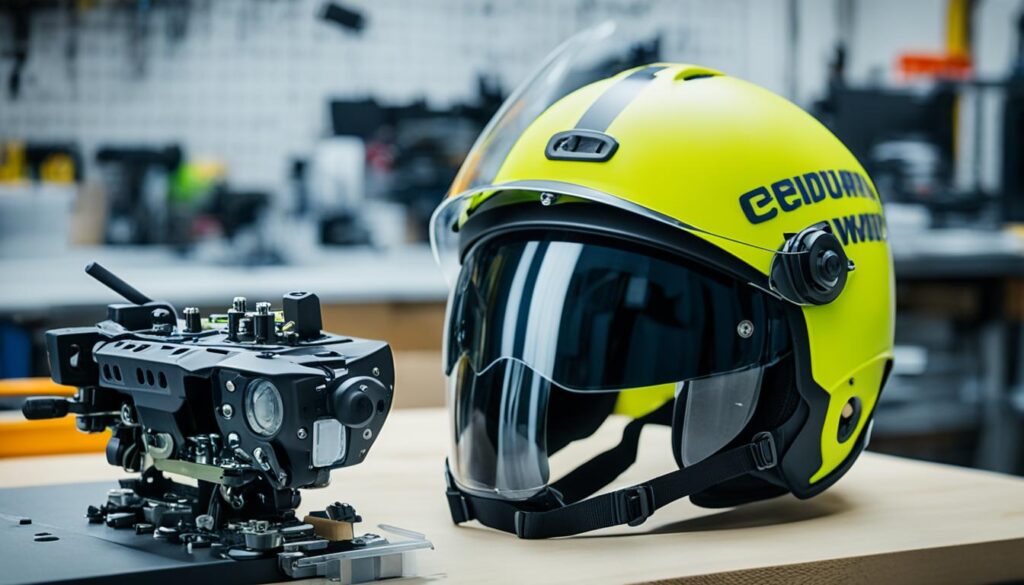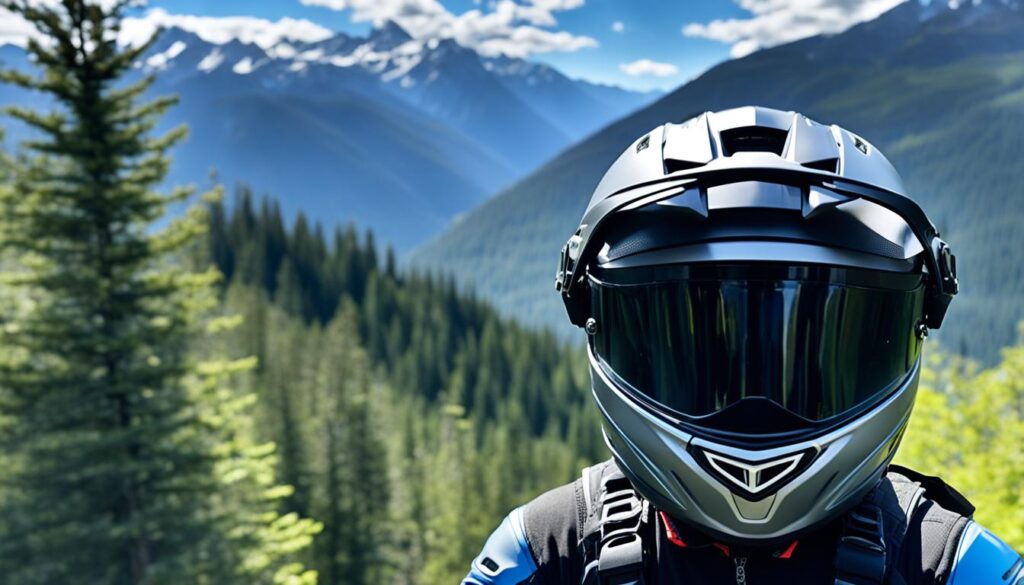
Have you ever wondered how to capture your thrilling motorcycle or bicycle rides from a first-person perspective? Installing a helmet camera allows you to relive those adrenaline-filled moments and share them with others. But how exactly do you set up a helmet camera? Is it a complicated process that requires technical expertise?
In this comprehensive step-by-step guide, we will demystify the helmet camera installation process. From choosing the right mount to securely attaching the camera to your helmet, we will walk you through each stage, ensuring you have a secure and stable setup.
Key Takeaways:
- Attaching an action camera to your helmet allows you to capture first-person footage during thrilling rides.
- You can choose between adhesive mounts or helmet mounts for attaching the camera to your helmet.
- Adhesive mounts provide a simple and effective attachment, while helmet mounts offer a more secure option.
- It’s crucial to follow the manufacturer’s instructions and ensure a secure attachment to prevent the camera from falling off.
- Prioritize safety and regularly check the stability of the camera mount to ensure a secure and stable setup.
Helmet Mounting Options for Action Cameras on Motorcycles
When it comes to mounting an action camera on your motorcycle helmet, there are several options available to ensure a secure attachment. Depending on your preference and the type of helmet you have, you can choose between adhesive mounts and helmet mounts.
Adhesive Mounts
An adhesive mount is one of the simplest and most common options for attaching an action camera to your motorcycle helmet. These mounts usually come with the camera and have a strong adhesive on one side that allows them to be directly attached to the helmet’s surface. The adhesive mounts are designed to withstand various weather conditions and vibrations, ensuring that your camera stays securely in place throughout your rides.
When installing an adhesive mount, it’s important to properly clean the surface of your helmet before attaching it. This ensures that the adhesive has a strong bond and prevents any dirt or debris from affecting the mount’s stability. Once the surface is clean, simply peel off the adhesive backing and firmly press the mount onto the desired location on your helmet.
Keep in mind that the placement of the adhesive mount is crucial for capturing the desired field of view. Take a moment to consider the angle and perspective you want to achieve before attaching the mount. This will ensure that you capture your riding adventures from the best possible angle.
Helmet Mounts
If you prefer a more secure attachment for your action camera, helmet mounts are another excellent option. These mounts are designed to be attached to your helmet’s ventilation holes or other mounting points, providing a sturdy and reliable connection.
Helmet mounts typically come with straps or screws that allow you to securely fasten the camera in place. They offer added stability and peace of mind knowing that your camera won’t come loose during your rides. Additionally, some helmet mounts may provide adjustable angles, allowing you to customize the camera’s position to your liking.
When installing a helmet mount, it’s important to follow the manufacturer’s instructions to ensure proper attachment. This includes tightening the straps or screws securely, checking for any potential movement or looseness, and adjusting the camera’s position for optimal recording.
Both adhesive mounts and helmet mounts offer their advantages, so it’s important to choose the option that best suits your needs and preferences. Whether you opt for the simplicity of adhesive mounts or the added security of helmet mounts, following the manufacturer’s instructions and ensuring a secure attachment will enable you to confidently capture your motorcycle adventures with your action camera.
Using Adhesive Mounts to Attach Action Cameras to Helmets
Adhesive mounts are a popular method for attaching action cameras to helmets. They provide a simple and effective way to securely fasten your camera, ensuring that it stays in place during your rides. To attach your action camera using adhesive mounts, follow these step-by-step instructions:
- Clean the helmet surface: Before attaching the adhesive mount, make sure to clean the surface of the helmet where you want to mount the camera. Use a mild detergent or alcohol wipe to remove any dirt or debris.
- Peel off the adhesive backing: Once the surface is clean, peel off the adhesive backing from the mount. Take care not to touch the adhesive with your fingers to maintain its stickiness.
- Position the mount: Carefully position the mount on the desired spot of your helmet. Take into consideration the field of view you want to capture and ensure that the camera will have a clear line of sight.
- Firmly press the mount: After positioning the mount, firmly press it onto the helmet’s surface, applying even pressure to ensure a secure attachment. Take a few moments to hold the mount in place to enhance adhesion.
It’s important to note that once the adhesive mount is attached, it may not be easily repositioned. Therefore, it’s crucial to take your time in choosing the optimal mounting location. Additionally, always follow the manufacturer’s instructions for the specific adhesive mount you are using to ensure proper installation.

By using adhesive mounts, you can securely attach your action camera to your helmet and capture stunning footage from your perspective. Just make sure to regularly check the mount’s adhesion and replace the adhesive if it starts to lose its stickiness. Now, let’s explore another mounting option for action cameras on helmets.
Strap Mounting Techniques for Action Cameras on Motorcycle Helmets
When it comes to attaching action cameras to motorcycle helmets, strap mounts offer a reliable and versatile solution. These mounts are designed with adjustable straps that securely hold the camera in place, providing stability and flexibility during rides.
Here’s a step-by-step guide on how to effectively attach an action camera with strap mounts:
- Choose the desired spot on your helmet where you want to mount the camera.
- Position the strap mount on the selected spot, ensuring it aligns with the camera’s field of view.
- Wrap the adjustable straps around the helmet, making sure they are tight enough to hold the camera securely.
- Double-check the alignment and tightness of the straps to prevent the camera from coming loose during rides.
Strap mounts provide the advantage of easy removal and repositioning of the camera, allowing you to adjust the angle or switch between different helmets. Furthermore, they offer a secure attachment that minimizes vibrations and ensures high-quality footage.
Advantages of Strap Mounts:
- Secure and stable attachment
- Easy removal and repositioning
- Compatibility with various helmet designs
- Minimization of vibrations for better video quality
With strap mounts, you can have peace of mind knowing that your action camera is securely fastened to your motorcycle helmet, capturing all your thrilling adventures with unmatched stability and precision.

| Mounting Option | Advantages | Disadvantages |
|---|---|---|
| Adhesive Mounts | Easy installation | Permanent attachment |
| Helmet Mounts | Secure attachment | Limited compatibility |
| Strap Mounts | Versatile and adjustable | Potential strap interference |
Installing Action Camera Mounts on Full-Face Motorcycle Helmets
When it comes to capturing your exciting motorcycle rides, full-face motorcycle helmets provide the perfect platform for mounting action cameras. To ensure a secure attachment, follow these steps:
- Clean the surface of your helmet where you plan to attach the camera mount. This will help ensure proper adhesion.
- Choose the right mount for your helmet. Different mounts are designed specifically for full-face helmets and offer secure attachment points.
- Position the mount in the desired location on your helmet. This can be on the top, sides, or chin area, depending on your preference and the type of shot you want to capture.
- Follow the manufacturer’s instructions to securely attach the mount to your helmet. This may involve using straps, screws, or other fastening mechanisms.
- Test the stability of the mount before hitting the road. Give it a gentle tug and ensure that it is firmly attached and won’t come loose during your rides.
- Consider the weight and balance of your action camera. Make sure it doesn’t affect the overall comfort of your helmet or compromise your safety while riding.
By following these steps and taking the necessary precautions, you can confidently install action camera mounts on your full-face motorcycle helmet, allowing you to capture incredible footage of your adventures on the road.
| Advantages | Considerations |
|---|---|
| Secure attachment points designed for full-face helmets | Weight and balance of the camera |
| Versatile positioning options for different camera angles | Proper cleaning and adhesion for secure attachment |
| Stable mount to prevent camera from coming loose | Testing stability before riding |
Securely Attaching an Action Camera to a Bicycle Helmet
When it comes to capturing your cycling adventures, attaching an action camera to your bicycle helmet allows you to record your rides from a first-person perspective. However, it’s essential to ensure a secure attachment to prevent the camera from falling off during your cycling adventures. Here’s a step-by-step guide on securely attaching an action camera to your bicycle helmet.
1. Choose a Helmet Mount Specifically Designed for Action Cameras
To start, select a helmet mount that is specifically designed for action cameras. These mounts are built to provide a secure and stable attachment to your helmet. Look for mounts that are compatible with your helmet model and have a track record of reliability.
2. Clean the Helmet Surface
Before attaching the mount, clean the surface of your bicycle helmet where you plan to mount the camera. Use a mild detergent or helmet cleaning solution to remove any dirt, debris, or oils from the surface. This will ensure a strong and lasting bond between the helmet and the mount.
3. Position and Press the Mount
Position the mount on the desired spot on your helmet, typically on the top or side to capture the best field of view. Firmly press the mount onto the helmet surface, ensuring it adheres securely. Apply even pressure for a few seconds to ensure proper bonding.
4. Test the Stability of the Mount
After attaching the mount, test its stability by gently tugging on it. Ensure that the mount is firmly attached and doesn’t move or come loose. If there is any sign of instability, reposition the mount and press it down firmly again. It’s crucial to have a secure and stable mount to prevent your camera from detaching during your rides.
5. Attach the Camera
Once the mount is securely attached, follow the manufacturer’s instructions to attach your action camera. Different camera models may have specific attachment mechanisms, such as clips, screws, or straps. Ensure that the camera is tightly fastened to the mount, providing a secure connection.
6. Prioritize Safety and Regularly Check the Mount’s Stability
Always prioritize safety while cycling with an action camera attached to your helmet. Regularly check the stability of the mount before each ride to ensure it remains securely attached. Inspect the mount for any signs of wear or damage and replace it if necessary. By maintaining a secure attachment, you can enjoy capturing and reliving your cycling adventures from an exciting first-person perspective.
Step-by-Step Guide: Mounting an Action Camera on a Helmet
To mount an action camera on a helmet, follow this step-by-step guide for a secure attachment:
- Choose the right mount for your helmet.
- Clean the surface of the helmet where you plan to attach the mount.
- Position the mount in the desired location on the helmet.
- Firmly press the mount onto the helmet.
- Test the stability of the mount to ensure it is securely attached.
- Attach the camera according to the manufacturer’s instructions.
- Make sure the camera is tightly fastened to the mount.
By following these steps, you can securely mount your action camera on your helmet and capture all the thrilling moments of your adventures.
Conclusion
Mounting an action camera on a helmet is a fantastic way to capture thrilling moments from a first-person perspective. Whether you’re exploring new trails on your mountain bike or cruising down the open road on your motorcycle, having a helmet camera setup allows you to document your adventures and relive the excitement later.
With a variety of mounting options available, such as adhesive mounts and helmet mounts, you can securely attach the camera to your helmet. It’s essential to carefully follow the manufacturer’s instructions for a proper installation and ensure a secure attachment. Regularly check the stability of the mount to prevent any unexpected mishaps while recording.
By prioritizing safety and taking the time to set up your helmet camera correctly, you can confidently hit the road or trail, knowing that your camera is securely mounted. So grab your helmet, choose the perfect mount for your needs, and dive into the world of helmet-mounted action footage!
Source Links
- https://www.kentfaith.com/blog/article_how-to-mount-action-camera-on-bicycle-helmet_11812
- https://www.kentfaith.com/blog/article_how-to-attach-action-camera-motorcycle-helmet_13763
- https://www.mohoc.com/wp-content/uploads/2017/05/Quick_Start_Guide_English_Rev_03_17_Low-Res.pdf

Meet James Smith, affectionately known by friends as ‘Biker Smith’, your go-to expert at ‘Best HD Helmet Camera’. At 35, living in the USA, James embodies the spirit of adventure. His life is a thrilling ride, powered by his Harley Davidson Softail and BMW S 1000 RR, with his girlfriend as his favorite travel companion. A software developer by profession, James’s heart beats for the open road, making him a full-time traveler at heart. His passion for biking and technology merges seamlessly on this platform. Recognizing a gap in discussions around helmet cameras, he founded this blog to educate and inspire fellow enthusiasts. His mission? To elevate your riding experience with the best HD helmet camera insights, backed by firsthand experiences, rigorous testing, and a genuine love for the ride. Trust James to guide you through the world of helmet cameras, where quality, innovation, and safety ride together.